Assessment of Ecotoxicity of Incinerated Sewage Sludge Ash (ISSA)
Abstract
:1. Introduction
2. Materials and Methods
- Fly ash, which is produced by capturing the mineral fraction and heavy metals in solid form through a multicyclone and electrostatic filter. It is classified as non-hazardous waste [29] with code 19 01 14 and labelled as FA in the paper;
- Solid waste consisting of the products of a chemical process to remove gaseous pollutants (due to the introduction of acidic sodium carbonate and activated carbon) and residual ash. Waste is caught with a bag filter. It is classified as hazardous waste [29], with code 19 01 07 and labelled as FACH in the paper.
- Chemical composition analysis, where waste was digested using a mixture of HNO3/HCl in a microwave oven. The obtained solution was analysed after dilution by the Inductively Coupled Plasma Spectrometry/Atomic Emission Spectroscopy (ICP-AES) and by the Inductively Coupled Plasma Mass Spectrometry (ICP-MS) with a Perkin Elmer Elan 6100 (PerkinElmer Inc., Waltham, MA, USA) apparatus;
- Leachability tests were conducted according to the EN 12457-2 standard [30]. The distilled water, with a liquid-to-solid ratio (L/S) of 10, was used as a leaching solution. The suspension was agitated in a plastic flask for 24 h, and then the mixture was filtered through a 0.45 µm membrane filter. The resulting leachate was analysed for pH using potentiometric method and trace elements using the ICP-AES and ICP-MS methods. The content of chlorides was analysed using the Volhard titration method.
- The ecotoxicological properties of the tested wastes were analysed using a standard phytotoxicity test against garden cress (Lepidium sativum) and vegetation tests against Lepidium sativum and Sinapis alba. For the phytotoxicity test, an aqueous extract of the test waste was prepared, and then a series of dilutions of the aqueous extract was produced with distilled water at concentrations of: 12.5%, 25%, 50%, and 100%. 5 mL each of the prepared solutions was transferred (three replicates each) to Petri dishes lined with filter paper, and 10 seeds per each dish (Lepidium sativum) were introduced. Control objects were also prepared with distilled water instead of the waste aqueous extract solution (three replicates were prepared for all dilutions and controls). All test objects were left to incubate, and after 72 h, the number of germinated seeds was determined, and the length of roots and stems was measured.
- The pot experiment consisted of growing test plants in specially prepared media, which were mixtures of universal plant growth medium (pH 5.5) and tested waste (content: 10%, 20% and 30% by volume). Reference (control) objects were also prepared, with no waste added. Ten seeds of test plants were sown into each pot; each experimental condition was produced in triplicate. Plants were grown under controlled laboratory conditions (in terms of humidity and light access). Observations of germination and early plant growth were conducted for fourteen days. One-way Analysis of variance (ANOVA) and Tukey’s post-hoc tests were used to statistically evaluate the effect of the medium on plant development using the Statistica 13.1 software.
3. Results and Discussion
3.1. Chemical Composition
3.2. Leachability of Chemical Contaminants
3.3. Toxicity Test
4. Conclusions
Author Contributions
Funding
Data Availability Statement
Conflicts of Interest
References
- Cieślik, B.; Namieśnik, J.; Konieczka, P. Review of sewage sludge management: Standards, regulations and analytical methods. J. Clean. Prod. 2015, 90, 1–15. [Google Scholar] [CrossRef]
- Zhao, J.; Hou, T.; Zhang, Z.; Shimizu, K.; Lei, Z.; Lee, D.-J. Anaerobic co-digestion of hydrolysate from anaerobically digested sludge with raw waste activated sludge: Feasibility assessment of a new sewage sludge management strategy in the context of a local wastewater treatment plant. Bioresour. Technol. 2020, 314, 1–8. [Google Scholar] [CrossRef]
- Cieślik, B.; Konieczka, P. A review of phosphorus recovery methods at various steps of wastewater treatment and sewage sludge management. The concept of “no solid waste generation” and analytical methods. J. Clean. Prod. 2017, 142, 1728–1740. [Google Scholar] [CrossRef]
- Donatello, S.; Cheeseman, C.R. Recycling and recovery routes for incinerated sewage sludge ash (ISSA): A review. Waste Manag. 2013, 33, 2328–2340. [Google Scholar] [CrossRef]
- Neuwahl, F.; Cusano, G.; Benavides, J.G.; Holbrook, S.; Roudier, S. Best Available Techniques (BAT) Reference Document for Waste Incineration; Publications Office of the European Union: Luxembourg, 2019. [Google Scholar]
- Li, M.; Xiang, J.; Hu, S.; Sun, L.-S.; Su, S.; Li, P.-S.; Sun, X.-X. Characterization of solid residues from municipal solid waste incinerator. Fuel 2004, 83, 1397–1405. [Google Scholar] [CrossRef]
- Vassilev, S.V.; Vassileva, C.G.; Karayigit, A.I.; Bulut, Y.; Alastuey, A.; Querol, X. Phase–mineral and chemical composition of composite samples from feed coals, bottom ashes and fly ashes at the Soma power station, Turkey. Int. J. Coal Geol. 2005, 61, 35–63. [Google Scholar] [CrossRef]
- Borowski, G. Przetwarzanie popiołu ze spalania osadów ściekowych na materiał budowlany/Processing of ashes from sewage sludgecombustion for building material. Inżynieria Ekologiczna 2011, 25, 251–258. [Google Scholar]
- Smol, M.; Kulczycka, J.; Henclik, A.; Gorazda, K.; Wzorek, Z. The possible use of sewage sludge ash (SSA) in the construction industry as a way towards a circular economy. J. Clean. Prod. 2015, 95, 45–54. [Google Scholar] [CrossRef]
- Rutkowska, G.; Chalecki, M.; Żółtowski, M. Fly ash from thermal conversion of sludge as a cement substitute in concrete manufacturing. Sustainability 2021, 13, 4182. [Google Scholar] [CrossRef]
- Rutkowska, G.; Ogrodnik, P.; Fronczyk, J.; Bilgin, A. Temperature influence on ordinary concrete modified with fly ashes from thermally conversed municipal sewage sludge strength parameters. Materials 2020, 13, 52–59. [Google Scholar]
- Lynn, C.J.; Dhir, R.K.; Ghataora, G.S.; West, R.P. Sewage sludge ash characteristics and potential for use in concrete. Constr. Build. Mater. 2015, 98, 767–779. [Google Scholar] [CrossRef] [Green Version]
- Cheeseman, C.R.; Virdi, G.S. Properties and microstructure of lightweight aggregate produced from sintered sewage sludge ash. Resour. Conserv. Recycl. 2005, 45, 18–30. [Google Scholar] [CrossRef]
- Stempkowska, A.; Kępys, W.; Pietrzyk, J. Wpływ właściwości fizykochemicznych stałych pozostałości z termicznego przekształcania osadów ściekowych na możliwość ich wykorzystania w ceramice czerwonej. Gospod. Surowcami Miner. Miner. Resour. Manag. 2015, 31, 109–122. [Google Scholar]
- Chen, L.; Lin, D.-F. Stabilization treatment of soft subgrade soil by sewage sludge ash and cement. J. Hazard. Mat. 2009, 162, 321–327. [Google Scholar] [CrossRef] [PubMed]
- Krüger, O.; Adam, C. Recovery potential of German sewage sludge ash. Waste Manag. 2015, 45, 400–406. [Google Scholar] [CrossRef]
- Kępys, W.; Pomykała, R.; Pietrzyk, J. Study of the Properties of the Ash-Water Suspension of the Incinerated Sewage Sludge Ash (ISSA). Inzynieria Miner. 2014, 15, 205–212. [Google Scholar]
- Cyr, M.; Coutand, M.; Clastres, P. Technological and environmental behavior of sewage sludge ash (SSA) in cement-based materials. Cem. Concr. Res. 2007, 37, 1278–1289. [Google Scholar] [CrossRef]
- Smol, M.; Kulczycka, J.; Kowalski, Z. Sewage sludge ash (SSA) from large and small incineration plants as a potential source of phosphorus—Polish case study. J. Environ. Manage. 2016, 184, 617–628. [Google Scholar] [CrossRef] [PubMed]
- Donatello, S.; Tong, D.; Cheeseman, C.R. Production of technical grade phosphoric acid from incinerator sewage sludge ash (ISSA). Waste Manag. 2010, 30, 1634–1642. [Google Scholar] [CrossRef] [Green Version]
- Fang, L.; Li, J.-S.; Guo, M.Z.; Cheeseman, C.R.; Tsang, D.C.W.; Donatello, S.; Poon, C.-S. Phosphorus recovery and leaching of trace elements from incinerated sewage sludge ash (ISSA). Chemosphere 2018, 193, 278–287. [Google Scholar] [CrossRef] [PubMed]
- Li, J.-S.; Wang, Q.; Chen, Z.; Xue, Q.; Chen, X.; Mu, Y.; Poon, C.S. Immobilization of high-Pb contaminated soil by oxalic acid activated incinerated sewage sludge ash. Environ. Pollut. 2021, 284, 117–120. [Google Scholar] [CrossRef] [PubMed]
- Lin, W.Y.; Ng, W.C.; Wong, B.S.E.; Teo, S.L.-M.; do Sivananthan, G.; Baeg, G.H.; Ok, Y.S.; Wang, C.-H. Evaluation of sewage sludge incineration ash as a potential land reclamation material. J. Hazard. Mater. 2018, 357, 63–72. [Google Scholar] [CrossRef] [PubMed]
- Iżewska, A.; Wołoszyk, C. Effect of fertilization with ash from municipal sewage sludge combustion on the chemical properties of light soil. Annual Set. Environ. Protect. 2014, 16, 486–497. [Google Scholar]
- Hudziak, G.; Gorazda, K.; Wzorek, Z. Main directions in application of ash after thermal treatment of sewage sludge. Tech. Trans. Chem. 2012, 16, 41–50. [Google Scholar]
- Krzywy, E.; Ciubak, J.; Cydzik, E.; Możdzer, E.; Kucharska, M. Utilization of municipal sewage sludge and lignite ashes for the production of fertilizer granules. Chemik 2012, 66, 1163–1168. [Google Scholar]
- Rosik-Dulewska, C.; Nocoń, K.; Karwaczyńska, U. Wytwarzanie Granulatu z Komunalnych Osadów ściekowych i Popiołów Lotnych w celu ich Przyrodniczego (Nawozowego) Odzysku; Instytut Podstaw Inżynierii Środowiska Polskiej Akademii Nauk: Zabrze, Poland, 2016. [Google Scholar]
- Fialova, J.; Hybska, H.; Mitterpach, J.; Samesowa, D.; Kovalicek, J.; Surowy, J.; Martauz, P. Bottom ash from municipal solid waste incineration. Basic parameters and ecotoxicological properties. Environ. Prot. Eng. 2019, 45, 113–125. [Google Scholar] [CrossRef]
- EN 12457-2. Characterization of Waste—Leaching—Compliance Test for Leaching of Granular Waste Materials and Sludges—Part 2: One Stage Batch Test at a Liquid to Solid Ratio of 10l/kg for Materials with Particle Size below 4 mm (without or with Size Reduction); European Committee for Stadardization: Brussels, Belgium, 2002. [Google Scholar]
- 2000/532/EC. Commission Decision of 3 May 2000 Replacing Decision 94/3/EC Establishing a List of Wastes Pursuant to Article 1(a) of Council Directive 75/442/EEC on Waste and Council Decision 94/904/EC Establishing a List of Hazardous Waste Pursuant to Article 1(4) of Council Directive 91/689/EEC on Hazardous Waste (Notified under Document Number C(2000) 1147); Official Journal of the European Communities. Available online: https://eur-lex.europa.eu/legal-content/EN/ALL/?uri=celex%3A32000D0532 (accessed on 26 July 2021).
- Kasina, M.; Kowalski, P.R.; Kajdas, B.; Michalik, M. Assessment of valuable and critical elements recovery potential in ashes from processes of solid municipal waste and sewage sludge thermal treatment. Resources 2020, 9, 131. [Google Scholar] [CrossRef]
- Nakić, D.; Vouk, D.; Donatello, S.; Vučinić, A.A. Environmental impact of sewage sludge ash assessed through leaching. Eng. Rev. 2017, 37, 222–234. [Google Scholar]
- Polish Legal act: Rozporządzenie Ministra Gospodarki Morskiej i Żeglugi Śródlądowej z dnia 12 lipca 2019 r. w Sprawie Substancji Szczególnie Szkodliwych dla środowiska Wodnego oraz Warunków, Jakie Należy Spełnić przy Wprowadzaniu do wód lub do Ziemi ścieków, a Także przy Odprowadzaniu wód Opadowych lub Roztopowych do wód lub do Urządzeń Wodnych. Available online: https://isap.sejm.gov.pl/isap.nsf/DocDetails.xsp?id=WDU20190001311 (accessed on 25 May 2021).
- Lynn, C.J.; Dhir, R.K.; Ghataora, G.S. Environmental impacts of sewage sludge ash in construction: Leaching assessment. Resour. Conserv. Recycl. 2018, 136, 306–314. [Google Scholar] [CrossRef]
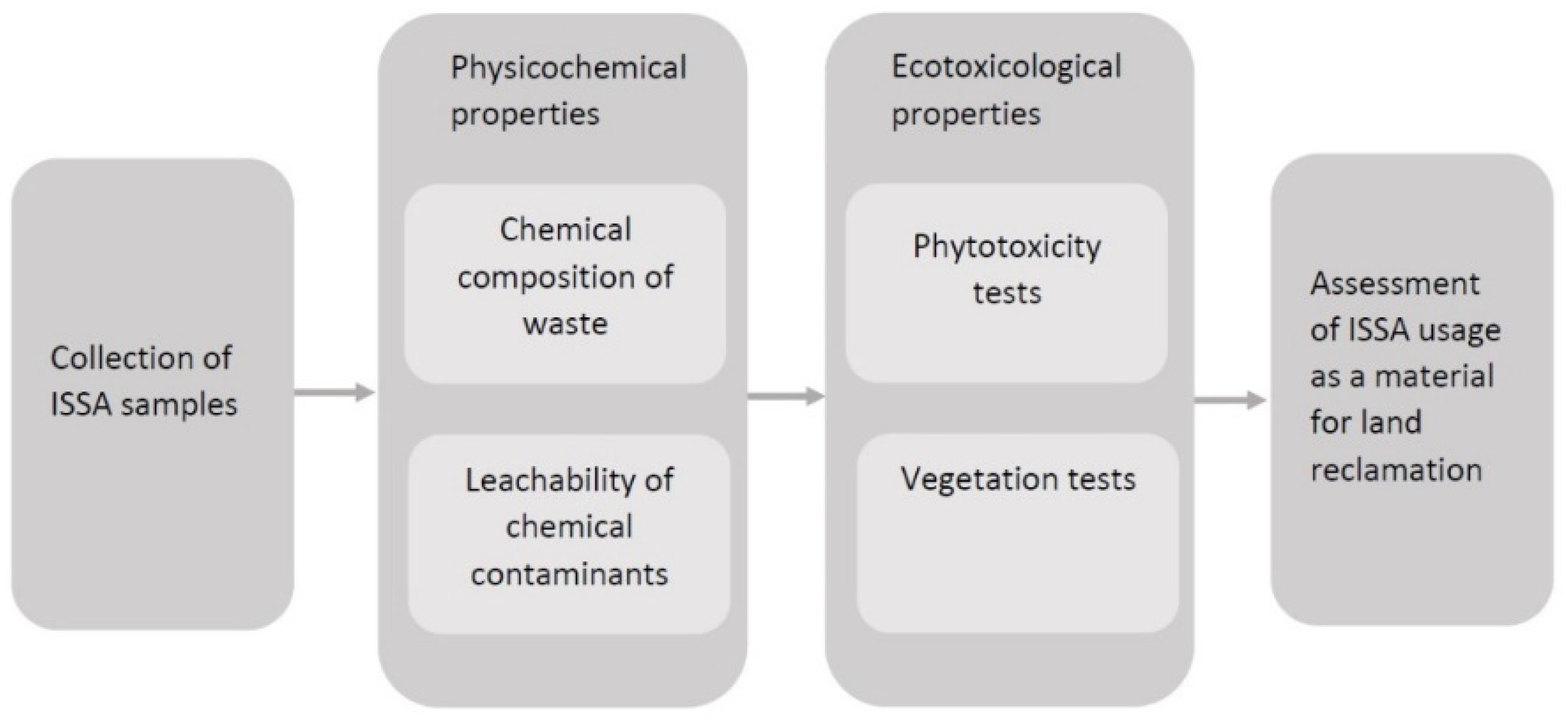
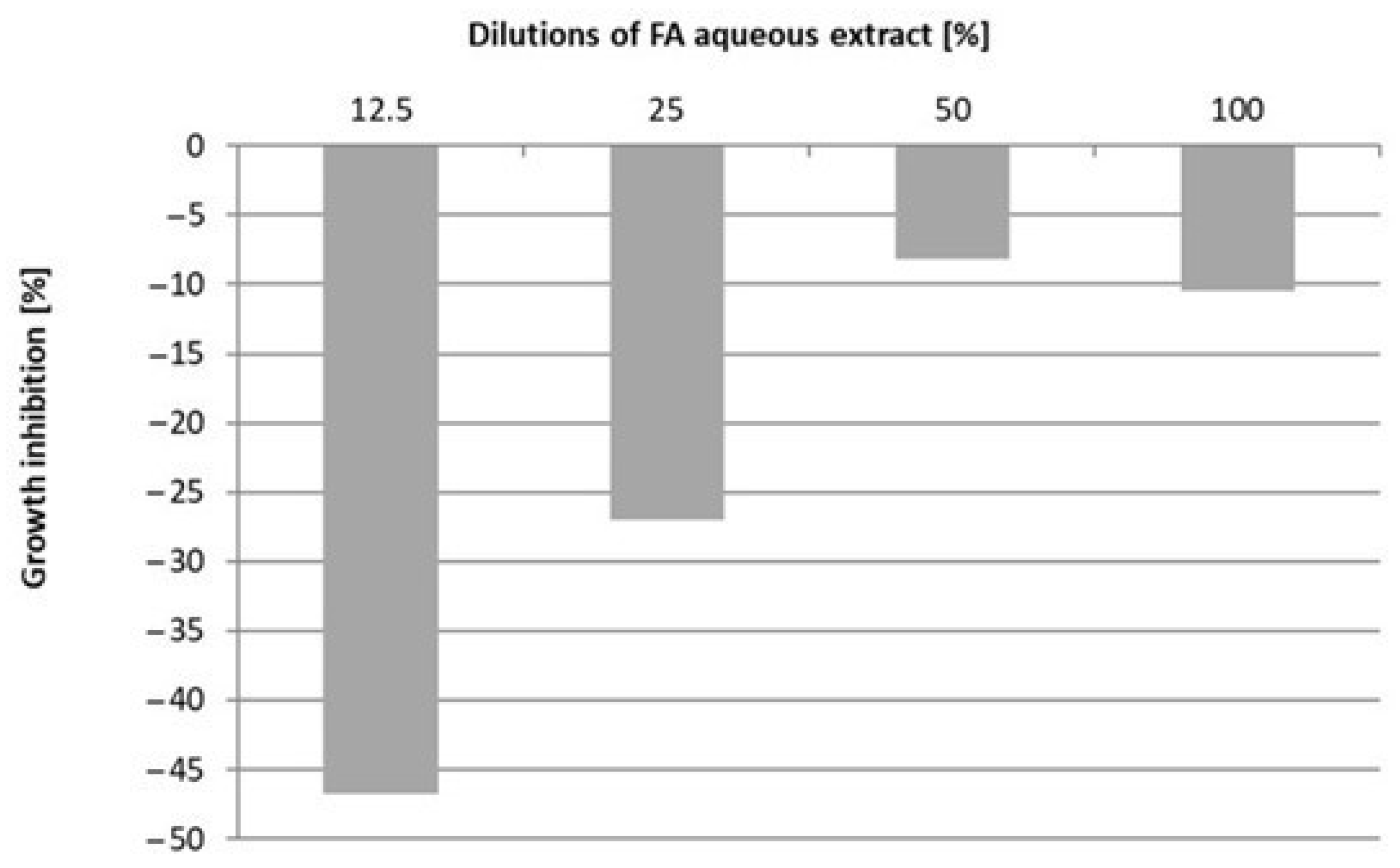
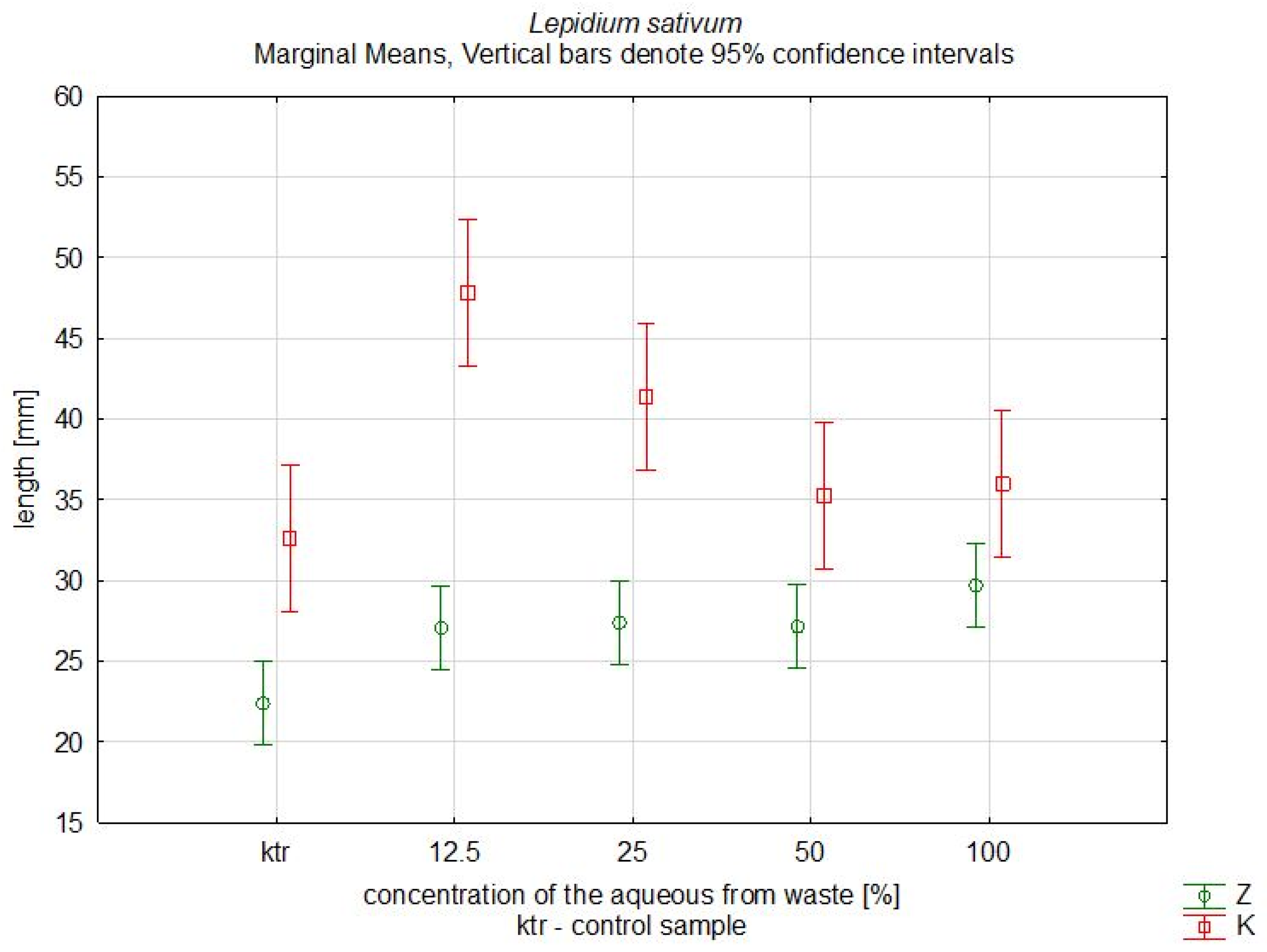
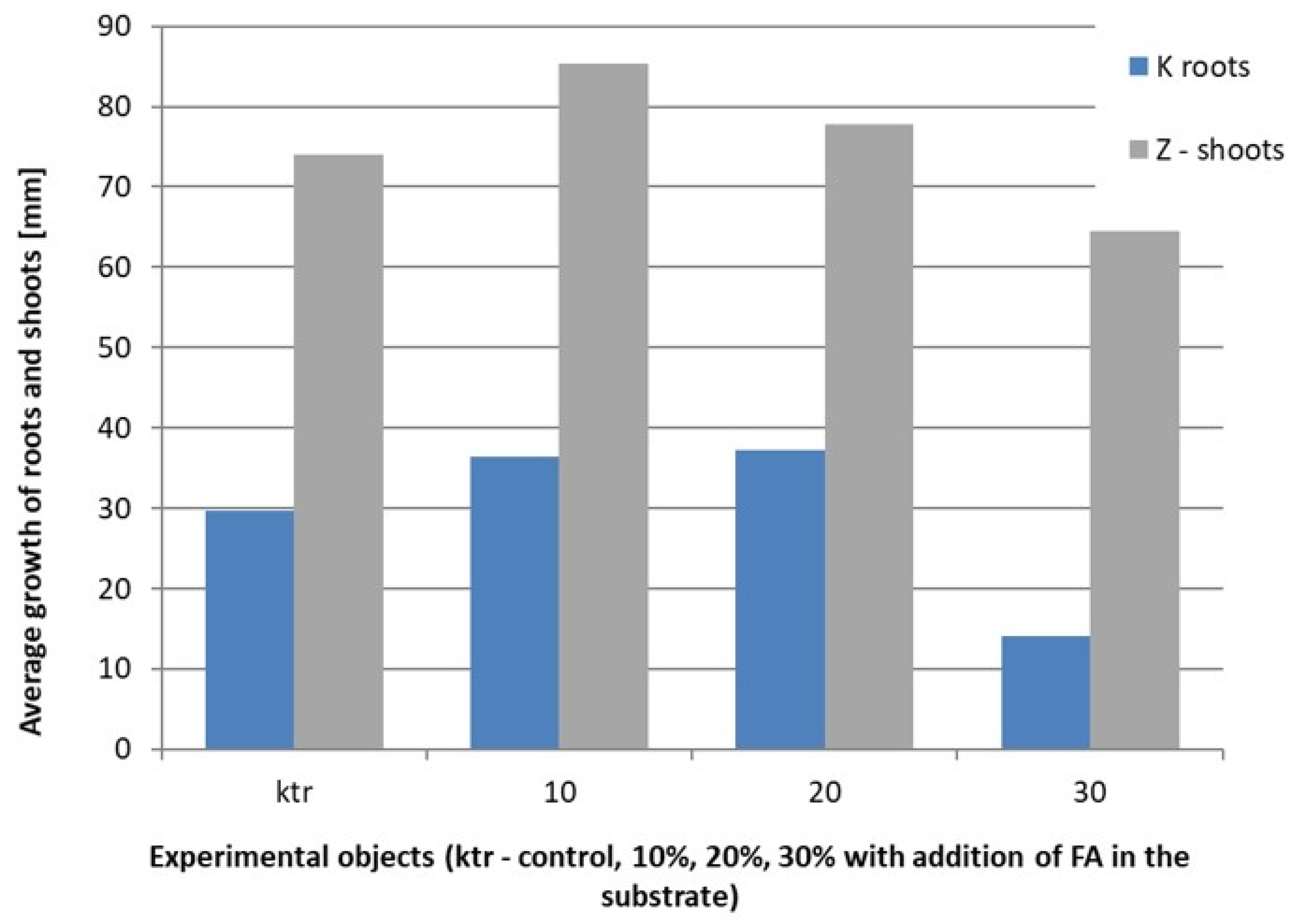
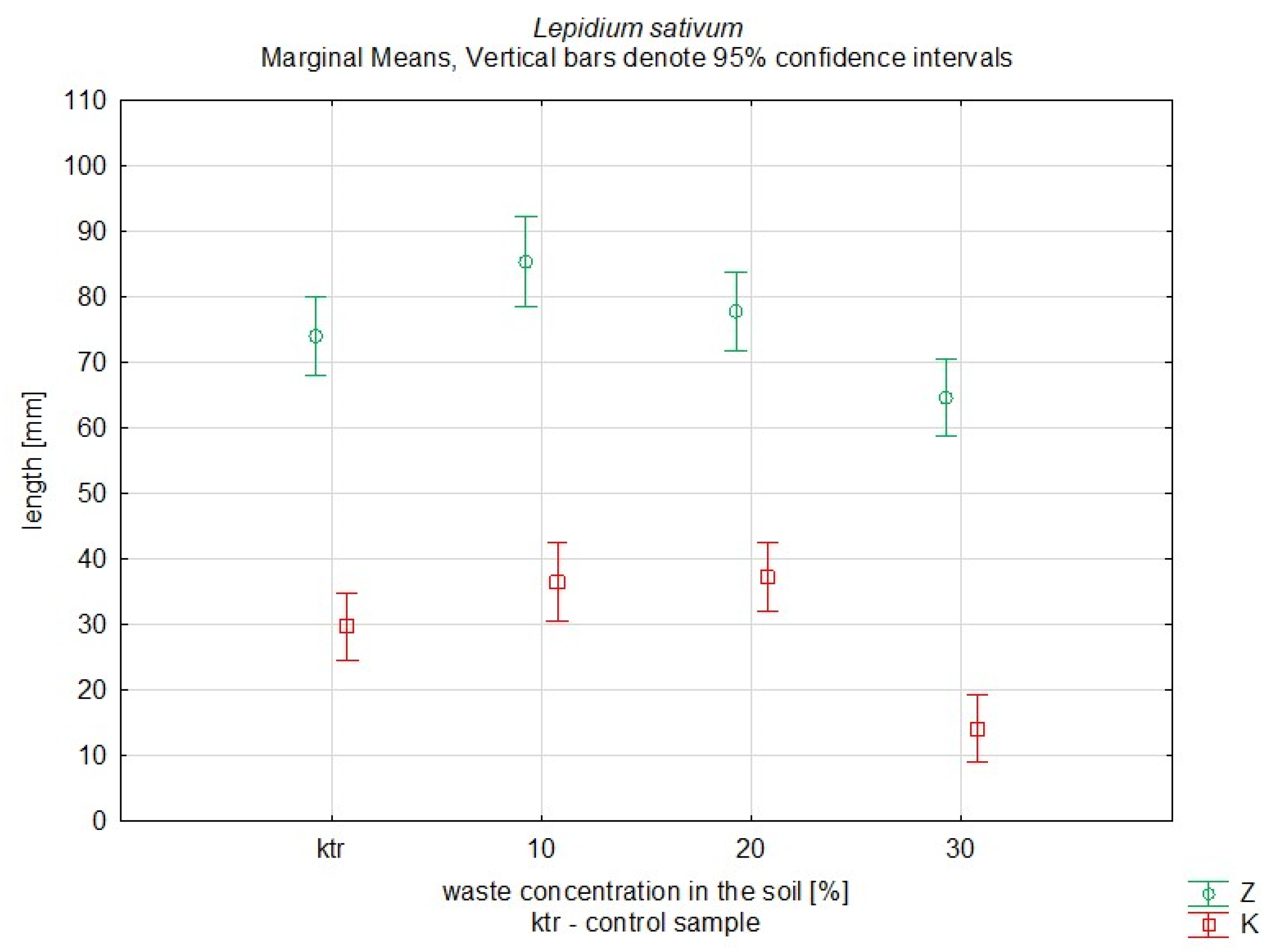
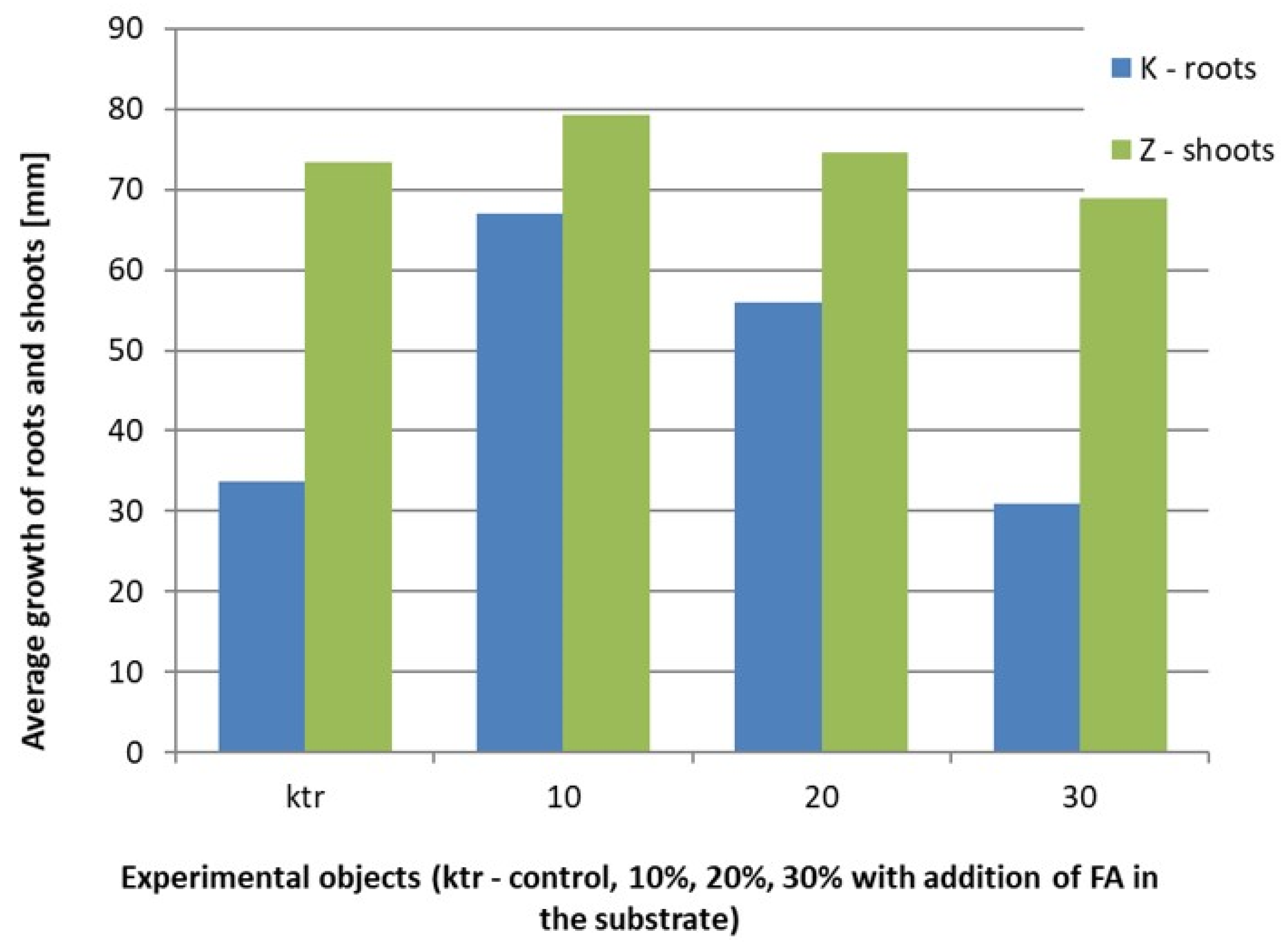
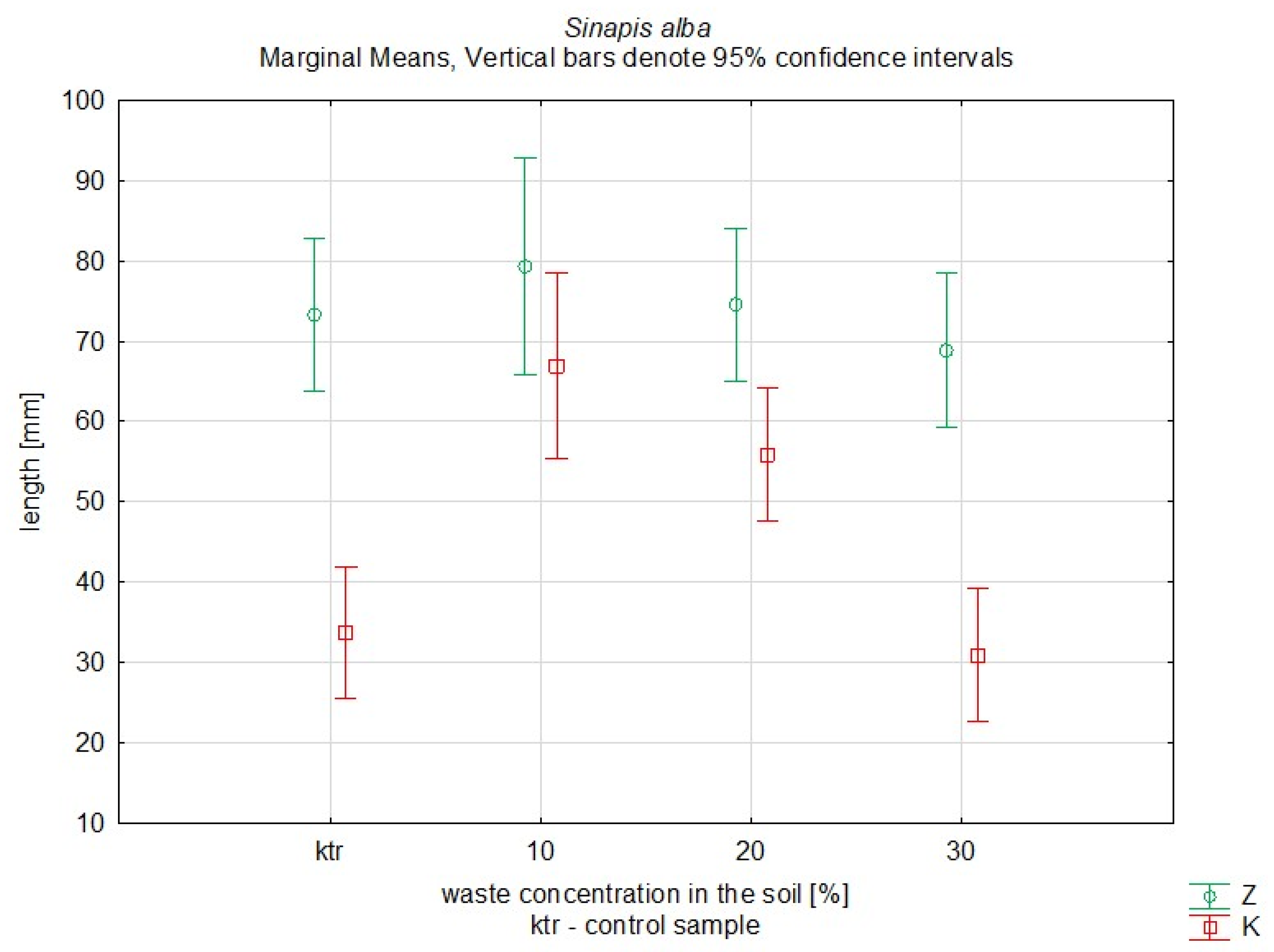
| Symbol of Waste | Chemical Composition [% Dry Mass] | |||||||||||
|---|---|---|---|---|---|---|---|---|---|---|---|---|
| P2O5 | Mn2O5 | SiO2 | Al2O3 | Fe2O3 | CaO | MgO | K2O | Na2O | SO3 | |||
| FA | 26.40 | 0.14 | 37.80 | 4.48 | 5.53 | 15.93 | 3.94 | 1.65 | 0.59 | 2.07 | ||
| FACH | 0.16 | 0.01 | 2.50 | 0.06 | 0.10 | 0.27 | 0.10 | 0.05 | 34.28 | 54.52 | ||
| Trace element content [mg·kg−1] | ||||||||||||
| Symbol of waste | As | Cd | Cr | Cu | Co | Hg | Ni | Pb | Ti | V | Zn | |
| FA | 6.75 | 3.09 | 471.50 | 838.01 | 18.00 | 0.09 | 108.64 | 109.67 | 3080 | 62.99 | 3861.9 | |
| FACH | 0.93 | 0.01 | 6.10 | 25.24 | 0.06 | 6.29 | 0.41 | 1.39 | 1201 | 0.68 | 33.15 | |
| Kind of Pollution | FA | FACH | Acceptable Value According to [33] [mg·dm−3] |
|---|---|---|---|
| Na | 66.70 | 38,608 | 800 |
| K | 87.43 | 10.20 | 80 |
| Ca | 237.50 | 11.43 | no requirements |
| Mg | 86.72 | 6.66 | no requirements |
| Zn | <0.002 * | <0.002 * | 2 |
| Cu | 0.0002 | 0.0026 | 0.5 |
| Ni | 0.0011 | 0.0003 | 0.5 |
| Co | 0.00019 | 0.0001 | 1 |
| Pb | 0.0004 | 0.0004 | 0.5 |
| Hg | 0.0020 | 0.0001 | 0.03 |
| Mn | 0.0260 | 0.0056 | no requirements |
| Se | <0.02 * | <0.02 * | 1.0 |
| Cd | 0.0012 | 0.00004 | 0.2 |
| Al | 0.1070 | 3.024 | 3.0 |
| Cr | 0.0002 | 0.0003 | 0.5 |
| Ti | 0.0006 | 0.00001 | 1.0 |
| As | 0.0136 | 0.002 | 0.1 |
| Mo | 0.952 | 0.002 | 1.0 |
| Cl− | 3.3 | 776.0 | 1000 |
| SO4−2 | 826.50 | 49,375 | 500 |
Publisher’s Note: MDPI stays neutral with regard to jurisdictional claims in published maps and institutional affiliations. |
© 2021 by the authors. Licensee MDPI, Basel, Switzerland. This article is an open access article distributed under the terms and conditions of the Creative Commons Attribution (CC BY) license (https://creativecommons.org/licenses/by/4.0/).
Share and Cite
Kępys, W.; Śliwka, M.; Pawul, M. Assessment of Ecotoxicity of Incinerated Sewage Sludge Ash (ISSA). Minerals 2021, 11, 849. https://doi.org/10.3390/min11080849
Kępys W, Śliwka M, Pawul M. Assessment of Ecotoxicity of Incinerated Sewage Sludge Ash (ISSA). Minerals. 2021; 11(8):849. https://doi.org/10.3390/min11080849
Chicago/Turabian StyleKępys, Waldemar, Małgorzata Śliwka, and Małgorzata Pawul. 2021. "Assessment of Ecotoxicity of Incinerated Sewage Sludge Ash (ISSA)" Minerals 11, no. 8: 849. https://doi.org/10.3390/min11080849
APA StyleKępys, W., Śliwka, M., & Pawul, M. (2021). Assessment of Ecotoxicity of Incinerated Sewage Sludge Ash (ISSA). Minerals, 11(8), 849. https://doi.org/10.3390/min11080849






